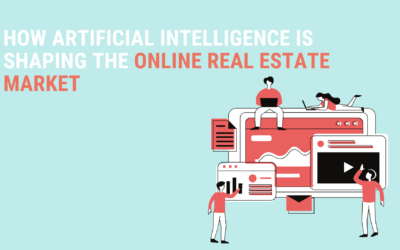Real estate technology: What we have today and how we got here
23 September 2020 | 4 min read

The history of Property Tech, also called PropTech is an interesting one. While other industries have welcomed the disrupting force of emerging AI-driven solutions, data science, and a fiercely customer-centric approach, the real estate industry has been slow to adapt. That is, until now.
In the last decade, and even in the last five years, we’ve seen some incredible developments in the real estate technology space. Many of these advancements have focused on the online real estate space. This makes a lot of sense, because today, half of all buyers find their new home online.
These developments are helping connect customers with the right properties, ensuring they get the best customer experience while shopping for their dream home or dream property development opportunity. For estate agencies and their websites, it’s meant higher quality leads, more sales, and happier customers. But how did we get here? Let’s take a look.
A brief history of real estate technology
Why is it so surprising that the real estate industry took so long to adopt new technology? After all, many other industries have also taken a long time to start utilizing Big Data. The traditional banking industry and the oil and gas sector also come to mind. However, what makes real estate unique, and what is truly remarkable about this slow adoption is that real estate is the largest asset class in the world. Real estate is worth more than all of the stock and bonds in the world combined.
Here is a brief overview of PropTech:
- 1980 to 2000 – This is what’s known as the Microsoft era. During this time PCs were becoming more popular and software companies started to develop tools to help with accounting, underwriting, and analytics in the real estate industry. However, these applications were often expensive and required extreme customization to work. They also didn’t integrate well with other systems and so their success was limited.
- 2001 to 2007 – This was really the birth of online real estate. At the beginning of the period, it was very difficult to find real estate information online. However, with the growth of social media, e-commerce, consumers began to see the internet as an extension of their real lives. They wanted to shop for real estate online, and there was a gap in the market for real estate companies to develop this technology. At the start of the period, it was almost impossible for the average user to buy, sell, or rent property online, but this was becoming more common for savvy users by the end of the period.
- 2008 to now – This period is defined by data and improving customer experiences. It’s now not enough to simply provide real estate information online, now companies want to only give you the most relevant information, and allow you to do the end to end process online, where possible.

Real estate technology in the digital age
Computer vision
Computer vision is a field of artificial intelligence that is focused on enabling computers to “see”, much in the same way we see. The computer vision market is expected to earn a whopping $48.32 billion between 2017 and 2023. Our brains process thousands of pieces of visual data, from the various wavelengths of light to the geometry of shapes, and more. Humans are great at using our eyes, but our vision is limited by the processing speed of our brain.
What does this mean? It means that we can look at one image and say “that’s a modern kitchen with white tiled floors and a granite worktop”. We can maybe look at a few images at once and still provide a quick response for what it is. But hundreds of images at once? That’s not something we excel at. With computer vision technology, we can analyze several thousands of images at lightning speed.
Here are some of the ways computer vision is used in real estate:
- Image tagging – The metadata can be used to tag specific items within real estate images so all users have to do is click on the item and find more information. Users can also easily find properties that have the aesthetic features they want, for example, a minimalistic or industrial style.
- Property comparison – This allows users to compare properties by using the information hidden within the image. For example, users can compare rooms in different properties based on how much natural light they let in, or the amount of floor space.
- Integration with AR and VR – AR and VR are set to be major disrupting forces in real estate. These technologies allow users to virtually walk through a property, or to play around with the property to visualize what it would look like with their furniture inside. Real estate companies are still experimenting with these technologies, but the potential they hold is immense.
Big data, Analytics, and AI
If you think this sounds like an ambitious section, then you’re right. However, here we hope to highlight the main ways advancements in these areas are disrupting the real estate industry for the better.
Real estate companies today who utilize data analytics are able to gain insights into the habits of buyers like never before. Websites are treasure troves of buyer intention and market preferences. Companies are able to collect data on buying and selling trends in certain areas, conduct consumer surveys, compile demographic information, and more. Armed with this information, they are better equipped to help potential buyers find the right home. By using historical and real-time data, you can drive predictive analytics systems and predict what your customers will want in the future. You can provide highly tailored and customized experiences to customers based on their customer persona. This means that customers don’t have to trawl through page after page of irrelevant content, which will often make them give up altogether.
AI and data analytics also plays a huge role in driving the decisions of property investors. It should come as no surprise that investors want to make the decision that will be the most profitable. It’s only by analyzing the data and looking for subtle trends that investors can get ahead of the competition and by the right properties at the right time. It’s for this reason that property investors and developers are increasingly aware of the importance of working with real estate companies who can use data to help them discover these subtle trends.
For example, over the last ten years, apartment buildings in Seattle within one mile of specialty grocery stories appreciated in value faster. However, it wasn’t just the proximity to these specialty stores like Whole Foods and Trader Joes that drove up prices, but also the quantity and quality of the community feature available. It turns out having two specialty stores within a quarter-mile of the property will drive up value, but having more than four will drive down value. This is the kind of information you can only gain through looking at the data.
AI chatbots
Many companies today are utilizing AI chatbots on their real estate portals, and with good reason. Chatbots have become an essential part of the digital landscape in 2020, and this is expected to continue into the future. Some industry predictions report that the majority of customer interactions will be handled by chatbots within the next few years – a bold claim, but not an unrealistic one either. One of the major reasons that chatbots are starting to become ubiquitous is that they are advancing rapidly. While in the past chatbots would be clunky and fail to understand context, nuance, or informal communication, the chatbots of today are impressively capable.
Here are some of the main benefits of having a chatbot for your online real estate portal:
24/7 Availability
One study found that 64% of internet users say 24-hour service is the best feature of chatbots. Providing a feature that customers like should be a good enough reason for real estate companies to implement chatbots, but there are distinct benefits for agencies themselves. Chatbots establish instant communication with the potential customer, starting the relationship early in the buying journey. Without a chatbot, the customer might decide to come back tomorrow to ask a question. If the alarmingly high rates of abandoned shopping carts across the retail industry tell you anything, it’s that customers often get busy, or forget, and they don’t come back.
Reduced Operational Costs
One study found that chatbots can cut operational costs by up to 30%. This can amount to huge cost savings for real estate companies.
Improved Engagement
Customers can communicate with your company at any time in the day, regardless of your operating hours, and regardless of whether they are on the go or working. By offering an instantaneous, 24/7, and casual communication channel, you drive customer engagement up.

Conclusion
In recent years, we’ve seen some massive developments in real estate technology, especially in the online real estate space. One of the biggest trends in online real estate technology has been the use of AI. This technology has made online real estate websites have less cost, be more engaging, and more efficient.
If you’re ready to dabble in one of these technologies and start providing better customer experiences, increase your conversions, and get ahead of your competitors, then we’re here to help. Reach out to us to get a free 30 min call with one of our experts and learn more about the possibilities of real estate technology. Contact us today.

AI and personalization made easy
Schedule your call today!


How House Alerts Help To Obtain Higher Click-Through Rates
Thanks to house alert systems, you can quickly inform potential buyers when new properties that match their criteria show up. Here is a step-by-step guide that will show you how you can retarget potential customers and help them find the house of their dreams.
Two Unique Dashboards That Will Help Your Real Estate Agents Close More Deals
Being successful in sales is about knowing your product inside out and knowing everything there is to know about your customer. Luckily, it’s easier to achieve these two goals today than ever before by using some unique dashboards. Read everything about it here:
How Artificial Intelligence is Shaping the Online Real Estate Market
Now in 2021, the message is clear; AI is here, and it’s here to stay. But what impact does this technology have on the real estate market? Read everything about it in this article



